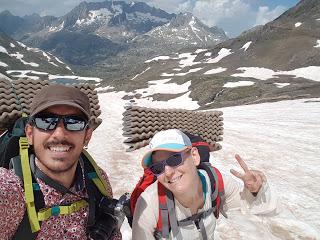
¿Qué cargamos? La gran pregunta que uno se hace antes de emprender una travesía por la montaña. Una cosa es hacer una excursión de una mañana o un día y la otra pasarse varias semanas por el monte. Lo más importante es darse cuenta de que la mochila que escojas va a ir llena, así que hay que encontrar la mochila grande más pequeña posible, para ahorrarse el peso innecesario. Marina llevaba una mochila de 40 litros y yo una de 70; nos dividimos la carga de tal manera que llevábamos prácticamente el mismo peso cada uno. Marina llevaba la comida, los bártulos de cocinar y el material de primeros auxilios y yo llevaba la tienda de campaña a veces dentro de la mochila y otras fuera, dependiendo de si iba a llover o no.Aproximadamente Marina cargaba 10 kg de peso sin contar el agua (hasta 2 kg extra dependiendo de la disponibilidad) y yo un pelín más por llevar el material de fotografía (también con 2 kg extra para agua). Las mochilas pesaban, pero bien amarradas a la cadera no suponen mayor problema. Un par de bastones son de gran ayuda.TECNOLOGÍA: Llevamos cada uno nuestro teléfono móvil con todos los mapas de los Pirineos descargados de internet con los recorridos marcados para poder seguirlos con el GPS. Yo llevaba un PowerBank con un par de cargas previendo los días en autosuficiencia. Marina llevaba además su Kindle donde tenía descargada una guía con la descripción de todas las etapas. También cargó con los mapas físicos impresos en papel que resultaron ser inútiles ya que la escala era demasiado grande y tenían marcados hitos erróneos o descatalogados como por ejemplo el cámping de Candanchú, que se había desmantelado hacía años.
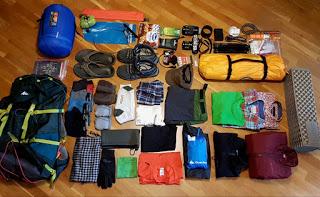 En cuanto al equipo de fotografía Marina llevaba su Pentax a prueba de torpezas (sumergible, shockproof, compacta y dura como el adamantium de Wolverine) y yo llevaba la Fujifilm X-T10 con un objetivo de 18-55 mm y otro de 55-200 mm además del cargador y varias tarjetas SD. Ambos llevábamos también unas linternas con unas pinzas para acoplarlas a un libro que fueron muy útiles porque también se pueden colgar de la cubierta de la tienda.SUPERVIVENCIA: Marina llevaba un botiquín completo y yo me limité a llevar polvo de talco y manta de emergencia (de esas que son doradas por un lado y plateadas por el otro). Ambos llevamos un saco de -5 grados de temperatura de comfort, cubre pantalón y chaqueta impermeable, bolsas Camelback de 2 litros para el agua, pastillas potabilizadoras y una botellita con cloro (también para potabilizar), esterilla aislante Thermarest y una pequeña colchoneta hinchable para dormir más cómodos, que ya tenemos una edad.NECESER: Crema de protección solar y cacao para los labios. Repelente para insectos, cepillos y pasta de dientes, papel higiénico al que le habíamos quitado el rollo de cartón, crema hidratante y toalla de microfibra de tamaño mediano. Llevamos una botellita de jabón respetuoso con el medio ambiente que tanto servía para lavar los calcetines como el pelo de la cabeza; una maravilla del Decathlon. Acabamos con un costurero de esos que dan en los hoteles con un par de agujas e hilos de colores que utilizamos para el par de ampollas que nos salieron en la zona de Navarra.INTENDENCIA: Un fogoncillo con una botella de gas y un pedernal para encender el fuego aunque lloviese o hiciese mucho viento. Llevábamos también un encendedor de gas para cuando no queríamos hacer el neandertal. Un par de sporks (tenedor, cuchara y cuchillo todo en uno), una olla y la Leatherman Wingman de Marina (yo llevé mi navaja Opinel con silbato de emergencia).
En cuanto al equipo de fotografía Marina llevaba su Pentax a prueba de torpezas (sumergible, shockproof, compacta y dura como el adamantium de Wolverine) y yo llevaba la Fujifilm X-T10 con un objetivo de 18-55 mm y otro de 55-200 mm además del cargador y varias tarjetas SD. Ambos llevábamos también unas linternas con unas pinzas para acoplarlas a un libro que fueron muy útiles porque también se pueden colgar de la cubierta de la tienda.SUPERVIVENCIA: Marina llevaba un botiquín completo y yo me limité a llevar polvo de talco y manta de emergencia (de esas que son doradas por un lado y plateadas por el otro). Ambos llevamos un saco de -5 grados de temperatura de comfort, cubre pantalón y chaqueta impermeable, bolsas Camelback de 2 litros para el agua, pastillas potabilizadoras y una botellita con cloro (también para potabilizar), esterilla aislante Thermarest y una pequeña colchoneta hinchable para dormir más cómodos, que ya tenemos una edad.NECESER: Crema de protección solar y cacao para los labios. Repelente para insectos, cepillos y pasta de dientes, papel higiénico al que le habíamos quitado el rollo de cartón, crema hidratante y toalla de microfibra de tamaño mediano. Llevamos una botellita de jabón respetuoso con el medio ambiente que tanto servía para lavar los calcetines como el pelo de la cabeza; una maravilla del Decathlon. Acabamos con un costurero de esos que dan en los hoteles con un par de agujas e hilos de colores que utilizamos para el par de ampollas que nos salieron en la zona de Navarra.INTENDENCIA: Un fogoncillo con una botella de gas y un pedernal para encender el fuego aunque lloviese o hiciese mucho viento. Llevábamos también un encendedor de gas para cuando no queríamos hacer el neandertal. Un par de sporks (tenedor, cuchara y cuchillo todo en uno), una olla y la Leatherman Wingman de Marina (yo llevé mi navaja Opinel con silbato de emergencia). 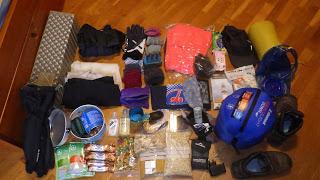 COMIDA: Empezamos llevando cous cous para cenar, avena para desayunar y barritas de cereales para comer durante el día. Esto pesa poco y da energía pero es bastante triste; acabamos aceptando llevar algo más de peso a cambio de un poco de felicidad alimenticia y empezamos a llevar sopas de sobre, pastillas avecrem, tabletas de chocolate, fajitas mejicanas con embutidos, muesly dulce tostado y, lo más importante, tubos de leche condensada. También cargamos algo de té y café instantáneo aunque a menudo tomábamos infusiones de hierbas silvestres. Durante las jornadas de excursión casi siempre pasábamos por algún lugar en el que vendía Aquarius a precio de grafeno para la estación espacial internacional.
COMIDA: Empezamos llevando cous cous para cenar, avena para desayunar y barritas de cereales para comer durante el día. Esto pesa poco y da energía pero es bastante triste; acabamos aceptando llevar algo más de peso a cambio de un poco de felicidad alimenticia y empezamos a llevar sopas de sobre, pastillas avecrem, tabletas de chocolate, fajitas mejicanas con embutidos, muesly dulce tostado y, lo más importante, tubos de leche condensada. También cargamos algo de té y café instantáneo aunque a menudo tomábamos infusiones de hierbas silvestres. Durante las jornadas de excursión casi siempre pasábamos por algún lugar en el que vendía Aquarius a precio de grafeno para la estación espacial internacional.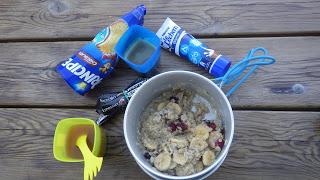
TIENDA: Doite Himalaya II que compramos en la Patagonia y que resultó resistir vendavales y diluvios. Una gran compra que pesa sólo 3,2 kg.ROPA: Cada día lavábamos en el río así que con cuatro mudas de ropa interior y calcetines nos sobró. Sólo llevamos un par de pantalones cortos, dos camisetas, un chaleco térmico, un abrigo de plumas y una chaqueta impermeable. Un gorro de lana y una gorra para la cabeza y unos guantes finos para las manos. Llevábamos también la “ropa de descansar y dormir” que eran unos calcetines de lana, unas mallas térmicas y una camiseta de algodón.LECTURA: Marina llevó en su Kindle “Do travel writers go to hell?” y “Homes d’honor” y yo llevé la copia en papel de “The catcher in the rye” que pesaba lo mismo que el Kindle que dejé en casa. VARIOS: Una libreta para apuntar las aventuras y desventuras diarias, los mapas de cada etapa, un par de bolsas de esas que se hacen una bolita para llevar las cosas que no quieres que te roben y una bolsa impermeable de 30 litros. Cordones de recambio que pueden servir para atar cosas y también como tendedero improvisado. Imperdibles: sirven para enganchar la ropa mojada a la mochila y que se seque al sol mientras caminas; imprescindibles.
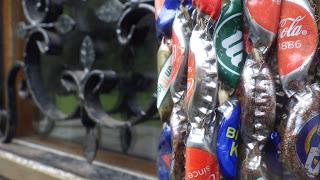 MATERIAL TÉCNICO: Crampones Petzl Leopard, polainas que nos salvaron tanto del barro como de la nieve y un par de bastones de trekking cada uno. Marina llevó sus botas Keen de Canadá y yo llevé las terribles Salomon que odio que tuve que comprar en Puerto Natales en enero de 2018 y que tuve que cambiar después de Núria por las Merrell sin Goretex que usaba en Nueva Zelanda cuando era verano. Ambos llevamos unas chanclas ligeras para cuando establecíamos el campamento para pasar la noche.Utilizamos todo el material que llevamos así que la jugada nos salió bien. Álex, el padre de Ainara que nos acogió en Irún, nos transmitió la cápsula de conocimiento de montañeros “cuando tengas hecha la mochila, deja la mitad de lo que has metido en ella y coge el doble de dinero del que llevabas” que utilizamos antes de salir cada una de las tres veces que salimos desde Barcelona hacia las montañas.LOS “FINDES” DE VERANOLos Pirineos no son la cordillera del Himalaya; son accesibles en coche desde grandes ciudades y tienen montañas y caminos de todos los niveles de dificultad. Son un terreno idóneo para domingueros y para montañeros himalayistas patrocinados por GoPro y Red Bull. Por este motivo los fines de semana de verano siempre hay actividades programadas. Ultratails, festivales de música, encuentros de artesanos… nosotros no lo previmos y en algún momento nos pilló a contrapié. En estos casos nos salvó la tienda de campaña: en concreto en tres fines de semana nos encontramos con eventos deportivos o festivaleros que habían colapsado los pueblos por los que pasábamos por lo que acampar fue literalmente la única opción posible.
MATERIAL TÉCNICO: Crampones Petzl Leopard, polainas que nos salvaron tanto del barro como de la nieve y un par de bastones de trekking cada uno. Marina llevó sus botas Keen de Canadá y yo llevé las terribles Salomon que odio que tuve que comprar en Puerto Natales en enero de 2018 y que tuve que cambiar después de Núria por las Merrell sin Goretex que usaba en Nueva Zelanda cuando era verano. Ambos llevamos unas chanclas ligeras para cuando establecíamos el campamento para pasar la noche.Utilizamos todo el material que llevamos así que la jugada nos salió bien. Álex, el padre de Ainara que nos acogió en Irún, nos transmitió la cápsula de conocimiento de montañeros “cuando tengas hecha la mochila, deja la mitad de lo que has metido en ella y coge el doble de dinero del que llevabas” que utilizamos antes de salir cada una de las tres veces que salimos desde Barcelona hacia las montañas.LOS “FINDES” DE VERANOLos Pirineos no son la cordillera del Himalaya; son accesibles en coche desde grandes ciudades y tienen montañas y caminos de todos los niveles de dificultad. Son un terreno idóneo para domingueros y para montañeros himalayistas patrocinados por GoPro y Red Bull. Por este motivo los fines de semana de verano siempre hay actividades programadas. Ultratails, festivales de música, encuentros de artesanos… nosotros no lo previmos y en algún momento nos pilló a contrapié. En estos casos nos salvó la tienda de campaña: en concreto en tres fines de semana nos encontramos con eventos deportivos o festivaleros que habían colapsado los pueblos por los que pasábamos por lo que acampar fue literalmente la única opción posible. 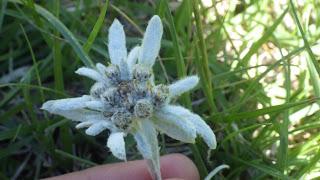 LA METEOROLOGÍAEmpezamos a caminar por el País Vasco donde tuvimos lluvias continuas los tres primeros días y niebla espesa las siguientes cinco jornadas. Tuvimos que parar durante un par de semanas para esperar a que la nieve se fundiese y aún así tuvimos que usar crampones en algunas ocasiones en la zona de Aragón. Pasado Andorra en dirección al Mediterráneo nos alcanzó la ola de calor famosa del verano de 2018 donde llegamos a caminar a casi 45 grados de temperatura bajo un sol de justicia. Marina y yo tenemos suerte de que nuestras familias y amigos tuvieron la disposición de ayudarnos intercambiar o desechar material de ruta. Gracias a sus visitas pudimos sustituir sacos de dormir de -5 grados, botas de alta montaña y crampones y acabamos caminando en zapatillas, con sacos de dormir de +15 y sin cargar la cocinilla ni el anorak.El verano llega a los Pirineos de repente y los contrastes entre la temperatura en los valles y en las cimas son muy grandes. Planear puntos de cambio de material en Núria e Isaba, por poner dos ejemplos, pensamos que es una muy buena idea en caso de querer hacer la Travesía Pirenaica de una tacada. Alternativamente a este uso de apoyo logístico, creemos que una muy interesante opción es hacer la travesía en varias épocas del año adecuadas a la estación que mejor se ajuste a las meteorología de cada zona. Es decir, reservar el verano para cubrir los tramos más altos de Aragón o Andorra; reservar el otoño para cubrir los tramos de la Garrotxa o los Pallars cuando las temperaturas y los colores del paisaje serán más amables; por dar un par de ejemplos. NUESTRA TRAVESÍA TRANSPIRENAICA:Etapa 1: Elizondo - SorogainEtapa 2: Sorogain - Hiriberri o Villanueva de AzpiazuEtapa 3: Hiriberri o Villanueva de Azpiazu - OchagavíaEtapa 4: Ochagavía - IsabaEtapa 5: Isaba - Peña Ezkaurre - IsabaEtapa 6: Isaba - Refugio de Aguas TuertasEtapa 7: Refugio de Aguas Tuertas - CandanchúEtapa 8: Candanchú - Sallent de GállegoEtapa 9: Sallent de Gállego - Refugio de BachimañaEtapa 10: Refugio de Bachimaña - BujarueloEtapa 11: Bujaruelo - Refugio de la Fuen BlancaEtapa 12: Refugio de la Fuen Blanca - Refugio de LalarriEtapa 13: Refugio de Lalarri - ParzánEtapa 14: Parzán - Refugio de Añes CrucesEtapa 15: Refugio de Añes Cruces - BenasqueEtapa 16: Benasque - Refugio de ConanglesEtapa 17: Refugio de Conangles - ColomersEtapa 18: Colomers - EspotEtapa 19: Espot - EstaónEtapa 20: Estaón - ÀreuEtapa 21: Àreu - ArinsalEtapa 22: Encamp - Cabana dels EsparversEtapa 23: Cabana dels Esparvers - VilallobentEtapa 24: Err - Vall de NúriaEtapa 25: Vall de Núria - Vallter 2000Etapa 26: Molló - Sant AniolEtapa 27: Sant Aniol - AlbanyàEtapa 28: Vilamaniscle - LlançàEtapa 29: Llançà - Cap de CreusEnrique & MarinaEnglish version
LA METEOROLOGÍAEmpezamos a caminar por el País Vasco donde tuvimos lluvias continuas los tres primeros días y niebla espesa las siguientes cinco jornadas. Tuvimos que parar durante un par de semanas para esperar a que la nieve se fundiese y aún así tuvimos que usar crampones en algunas ocasiones en la zona de Aragón. Pasado Andorra en dirección al Mediterráneo nos alcanzó la ola de calor famosa del verano de 2018 donde llegamos a caminar a casi 45 grados de temperatura bajo un sol de justicia. Marina y yo tenemos suerte de que nuestras familias y amigos tuvieron la disposición de ayudarnos intercambiar o desechar material de ruta. Gracias a sus visitas pudimos sustituir sacos de dormir de -5 grados, botas de alta montaña y crampones y acabamos caminando en zapatillas, con sacos de dormir de +15 y sin cargar la cocinilla ni el anorak.El verano llega a los Pirineos de repente y los contrastes entre la temperatura en los valles y en las cimas son muy grandes. Planear puntos de cambio de material en Núria e Isaba, por poner dos ejemplos, pensamos que es una muy buena idea en caso de querer hacer la Travesía Pirenaica de una tacada. Alternativamente a este uso de apoyo logístico, creemos que una muy interesante opción es hacer la travesía en varias épocas del año adecuadas a la estación que mejor se ajuste a las meteorología de cada zona. Es decir, reservar el verano para cubrir los tramos más altos de Aragón o Andorra; reservar el otoño para cubrir los tramos de la Garrotxa o los Pallars cuando las temperaturas y los colores del paisaje serán más amables; por dar un par de ejemplos. NUESTRA TRAVESÍA TRANSPIRENAICA:Etapa 1: Elizondo - SorogainEtapa 2: Sorogain - Hiriberri o Villanueva de AzpiazuEtapa 3: Hiriberri o Villanueva de Azpiazu - OchagavíaEtapa 4: Ochagavía - IsabaEtapa 5: Isaba - Peña Ezkaurre - IsabaEtapa 6: Isaba - Refugio de Aguas TuertasEtapa 7: Refugio de Aguas Tuertas - CandanchúEtapa 8: Candanchú - Sallent de GállegoEtapa 9: Sallent de Gállego - Refugio de BachimañaEtapa 10: Refugio de Bachimaña - BujarueloEtapa 11: Bujaruelo - Refugio de la Fuen BlancaEtapa 12: Refugio de la Fuen Blanca - Refugio de LalarriEtapa 13: Refugio de Lalarri - ParzánEtapa 14: Parzán - Refugio de Añes CrucesEtapa 15: Refugio de Añes Cruces - BenasqueEtapa 16: Benasque - Refugio de ConanglesEtapa 17: Refugio de Conangles - ColomersEtapa 18: Colomers - EspotEtapa 19: Espot - EstaónEtapa 20: Estaón - ÀreuEtapa 21: Àreu - ArinsalEtapa 22: Encamp - Cabana dels EsparversEtapa 23: Cabana dels Esparvers - VilallobentEtapa 24: Err - Vall de NúriaEtapa 25: Vall de Núria - Vallter 2000Etapa 26: Molló - Sant AniolEtapa 27: Sant Aniol - AlbanyàEtapa 28: Vilamaniscle - LlançàEtapa 29: Llançà - Cap de CreusEnrique & MarinaEnglish versionPYRENEES TRAIL GR11: STAGE INDEX (at the end), GEAR AND SOME THOUGHTS
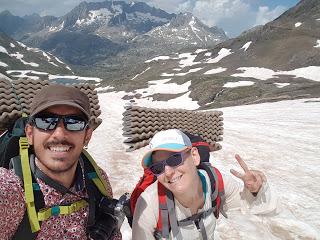 What did we take with us? Well, that is the key question to answer to start planning a long distance hike. Going for a day hike or a walk in the bush has nothing to do with spending several weeks in the backcountry. What we first came to realise a while ago was that regardless the size of your backpack it will always be fully packed. Therefore, you better pick the smallest size possible and save yourself to carry all the unnecessary gear you’d end up taking just because “there’s still room”. For this trip I took a 40 L backpack and Enrique a 70 L. Despite this difference in volume we split the weight pretty much evenly. I had all the food, cooking gear and a full first aid kit which was compact but heavier while Enrique took the tent which was large but lighter. Depending on the weather he would decide to leave the tent inside or outside of the backpack body. In numbers, I usually had on my shoulders 10 kg of dry gear plus drinking water which could weigh anything between 0.5 kg and 2 kg. Enrique used to carry about 11 kg of dry gear because he would add his photography set. He carried his water too, which would be anything between 0.5 kg to 2.5 kg. The packs were heavy, clearly. For those who do not know us very well, I weight around 50 kg and Enrique about 65 kg. Regardless, we managed to find the right way to feel comfortable with them on, we got used to them and most of the time we forgot about them. Saying that, trekking poles definitively helped us to feel that way.
What did we take with us? Well, that is the key question to answer to start planning a long distance hike. Going for a day hike or a walk in the bush has nothing to do with spending several weeks in the backcountry. What we first came to realise a while ago was that regardless the size of your backpack it will always be fully packed. Therefore, you better pick the smallest size possible and save yourself to carry all the unnecessary gear you’d end up taking just because “there’s still room”. For this trip I took a 40 L backpack and Enrique a 70 L. Despite this difference in volume we split the weight pretty much evenly. I had all the food, cooking gear and a full first aid kit which was compact but heavier while Enrique took the tent which was large but lighter. Depending on the weather he would decide to leave the tent inside or outside of the backpack body. In numbers, I usually had on my shoulders 10 kg of dry gear plus drinking water which could weigh anything between 0.5 kg and 2 kg. Enrique used to carry about 11 kg of dry gear because he would add his photography set. He carried his water too, which would be anything between 0.5 kg to 2.5 kg. The packs were heavy, clearly. For those who do not know us very well, I weight around 50 kg and Enrique about 65 kg. Regardless, we managed to find the right way to feel comfortable with them on, we got used to them and most of the time we forgot about them. Saying that, trekking poles definitively helped us to feel that way.TECH: Both of us carried our cell phones with the maps and the GPS track downloaded in the View Ranger app. Enrique took a small power bank worth two charges for the days in self-sufficiency. I decided to take my kindle with me which also had the fact sheet of every section of the trail downloaded. I got those section guides from the official website of each regional hiking federation. I carried paper maps for a long while until eventually I got sick of them and left them home. Even though I bought them this last June they were completely useless: the scale was too large, the icons were out of date such as camp sites closed for longer than 4 years or huts that had been washed down by the floods many years backs and they were single face printed, which made them heavier than they were worth.
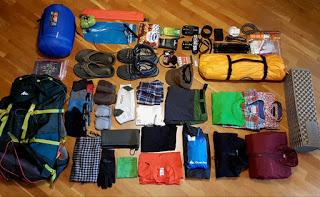
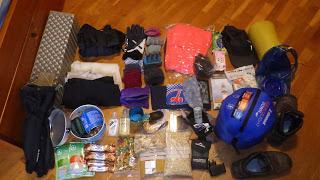 FOOD: We start the trail eating cous cous for dinner, porridge for breakfast and cereal bars for during the day. Theoretically, this was light and full of energy. Besides, it was tasteless. So we decided to add more grams to our packs while providing some happiness to our taste buds. Our diet then included packaged soups and chocolate for dinner; sugar packed granola, condensed milk and instant coffee for breakfast; wraps and vac packed sausages (sliced, local and as fancy and gourmet as possible) for lunch. Cookies were also present in our diet but we would be out of them a day after leaving town. We still carried muesli bars but we lost our interest in them and preferred nuts and dried fruit (cranberries, dates and peanuts have the highest energy value). Very often we had tea after dinner to be cosy at the camp. We had teabags from the market but most of the time I would make tea out of wild herbs and flowers found on the way.
FOOD: We start the trail eating cous cous for dinner, porridge for breakfast and cereal bars for during the day. Theoretically, this was light and full of energy. Besides, it was tasteless. So we decided to add more grams to our packs while providing some happiness to our taste buds. Our diet then included packaged soups and chocolate for dinner; sugar packed granola, condensed milk and instant coffee for breakfast; wraps and vac packed sausages (sliced, local and as fancy and gourmet as possible) for lunch. Cookies were also present in our diet but we would be out of them a day after leaving town. We still carried muesli bars but we lost our interest in them and preferred nuts and dried fruit (cranberries, dates and peanuts have the highest energy value). Very often we had tea after dinner to be cosy at the camp. We had teabags from the market but most of the time I would make tea out of wild herbs and flowers found on the way. 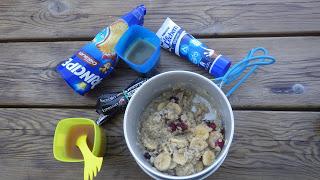
TENT: Doite Himalaya II bought in Punta Areanas, Chilean Patagonia. That tent turned out to be great in windy conditions, rain and storms. A great purchase that only weights 3.2 kg.
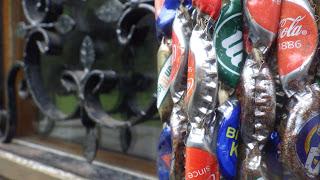
TECHNICAL GEAR: We both carried our Petzl Leopard crampons, trekking poles and gaiters that protected our pants and legs from mud, snow, dust and prickly plants. I wore my pair of Keen boots purchased in Banff all the way. I wanted to swap them for my Asics trail runners but my parents brought me the wrong shoes when we meet for the gear exchange. Enrique used the pair of Salomon boots purchased a few months back in Puerto Natales, Patagonia. He did exchange them for a pair of summer non-waterproof Merrell hiking shoes from our New Zealand years since the Salomons were is such bad state. We both also took a pair of flip flops to use during resting time and to cross rivers. A pair of river shoes would have been a good idea too although a bit heavier than the flip flops.
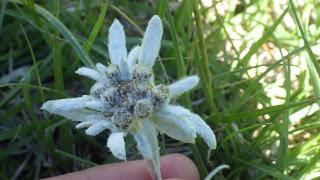
WEATHERThe trail started in the Basque Country where it normally is really wet and it definitively was for us over the first three days and foggy for the first five. We decided to hold the rest of the expedition for a couple of weeks to give some time for the snow to melt and the weather to turn more spring like. Nevertheless, we still needed crampons in some sections in Aragón. Past Andorra and closer to the Mediterranean coast, a heat wave caught us and brought the temperatures to over 45 degrees and a sun that would fry an egg over the track. Enrique and I were lucky that our family and friends live relatively close and had the time and will to help us swapping or dropping gear. Thanks to that we could switch from a -5 degrees sleeping bag to a summer bag, drop the crampons and the gas stove when all we could think of was a cold drink and tons of water and Enrique could get rid of his Salomons when they were literally falling a part and retrieve his summer hiking shoes. Summer gets to the Pyrenees suddenly and comes full of contrasts. The temperature gap between the valley and the summits is great and you always have to be ready for anything. In our opinion, if one is completing the route in a row, planning a few points to drop and pick up gear (as we did in Núria and Isaba) is the key to success or at least that made our experience more comfortable. Alternatively to getting logistic support, another option is to complete the route in stages matching the best time of the year for each part. For instance, this would include covering the highest altitude parts during the hottest months of summer when it’s unlikely to find snow and likely to be sunny; then visiting the area of la Garrotxa or even the Pallars in autumn when the temperatures decrease and the threes display an incredible variety of colours. That obviously takes longer which is not necessarily a bad thing. OUR ROUTE:Stage 1: Elizondo - SorogainStage 2: Sorogain - Hiriberri or Villanueva de AzpiazuStage 3: Hiriberri or Villanueva de Azpiazu - OchagavíaStage 4: Ochagavía - IsabaStage 5: Isaba - Peña Ezkaurre - IsabaStage 6: Isaba - Aguas Tuertas HutStage 7: Aguas Tuertas Hut- CandanchúStage 8: Candanchú - Sallent de GállegoStage 9: Sallent de Gállego - Bachimaña HutStage 10: Bachimaña Hut- BujarueloStage 11: Bujaruelo - Fuen Blanca ShelterStage 12: Fuen Blanca Shelter- Lalarri HutStage 13: Lalarri Hut - ParzánStage 14: Parzán - Añes Cruces ShelterStage 15: Añes Cruces Shelter - BenasqueStage 16: Benasque - Conangles HutStage 17: Conangles Hut- ColomersStage 18: Colomers - EspotStage 19: Espot - EstaónStage 20: Estaón - ÀreuStage 21: Àreu - ArinsalStage 22: Encamp - Esparvers ShelterStage 23: Esparvers Shelter - VilallobentStage 24: Err - Vall de NúriaStage 25: Vall de Núria - Vallter 2000Stage 26: Molló - Sant AniolStage 27: Sant Aniol - AlbanyàStage 28: Vilamaniscle - LlançàStage 29: Llançà - Cap de CreusEnrique & Marina
